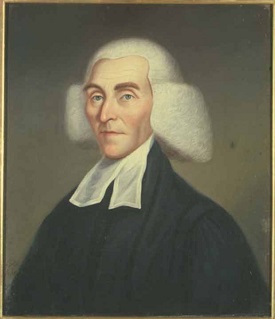Old Pine Street Presbyterian Church: Page 2
GEORGE DUFFIELD'S YEARS
The wounds between the "New Lights" and the "Old Lights" never really healed. Duffield was decidedly a "New Light." He was a frontier preacher, one of those hired by Alison to convert Native Americans living in the Wilderness. Traveling as far west as Ohio, Duffield had been successful in his proselytizing efforts. Members of Old Pine had heard Duffield preach on occasion and asked him to become their pastor.
Alison had hired Duffield to convert Indians, but was not about to allow him to pervert the Old Pine congregants.
When Duffield arrived, he found the doors to the church locked. Legend has it that friends and supporters of Duffield picked him up and literally threw him into the church through a window. Jimmy Bryant, a magistrate employed by the First Church, informed Duffield and his supporters that they were illegally assembled. Church member Robert Knox, in turn, grabbed Bryant by the scruff of the neck and seat of his pants and literally threw him out of the church door. Knox then calmly addressed the new Pastor and said, "Go on, Mr. Duffield."
The First Church went to the highest courts in an effort to regain Old Pine. Ultimately, the Revolution interceded and the matter was cleared up with a $4,250 payment from Old Pine to the First Church after the War's end.
THE REVOLUTIONARY WAR
Duffield preached for American Independence from Old Pine as well as in the field of battle. Appointed both Chaplain of the Pennsylvania Militia and co-Chaplain of the Continental Congress, Duffield left the church for the duration of the war. Sixty men from his congregation followed him into the army, many serving with distinction. John Steele was field officer the day Cornwallis surrendered at Yorktown. William Linnard launched cannon fire on the Hessians at the Battle of Germantown. George Latimer was so effective in fighting the British that a reward was offered for his capture — dead or alive. Duffield's oratory was so inimical to the British that they also put a price on his head. And so, after the war, Old Pine became known as "The Church of the Patriots."
During the British occupation of Philadelphia in 1777, the Old Pine Street Church was desecrated. First, royal troops used the building as a hospital. They tore up the pews and pulpit to make fires to warm their sick and dying. After being eviscerated, the church was turned into a stable. At this time too, the graveyard was profaned and used to bury over 100 mercenary Hessian troops. Not all churches suffered a similar fate. Right down Pine Street, St. Peter's, an Episcopal Church, served the British army as a church of choice in offering prayers to King George.
Old Pine Street Church was enlarged 1857, under the pastorship of Thomas Brainerd, who would go on to become a fervent anti-slavery activist. Upon completing the renovations, he wrote, "the church has been transformed into a beautiful and classic temple; uniting the associations of a venerated antiquity with the demands of modern taste." Greek Revival was the architectural style of the day in Philadelphia. World travelers like Second Bank president Nicholas Biddle had been to Europe and taken the grand tour. Upon returning to the States they brought back a love of the ancient world which was reflected in their estates and art collections.
THE CHURCH TODAY
It is hoped that the non-virtual tourist will make time to visit Old Pine Street Church. However, arrangements must be made in advance to tour the sanctuary. There, one will find a beautiful large room with a massive ceiling with no visible means of support. On the walls are restenciled patterns and symbols representing the church's history and ecumenical outlook. According to literature provided by the church, the intent of the symbols "is to lead people on a journey of faith from the remote past into the present and on into eternity."
The official name of The Old Pine Street Presbyterian Church is the Third, Scots and Mariners Presbyterian Church, reflective of the amalgamation over the past two centuries of a dozen congregations into the present site. A stencil of waves is symbolic of the Mariners' church. Thistle stencils, emblematic of Scotland, scrolls, stars of David, Papal tiaras, cornucopias, broken chains, and pine cones bedeck the walls. The pine, which figures prominently in Old Testament writings, receives special consideration as the church is situated on Pine Street.
- George Whitefield, a Calvinist Minister who led the "Great Awakening," spoke on the site of Pine Street Church before it was built.
- Legend has it that Whitefield could make people weep or tremble by the various ways he uttered the word "Mesopotamia."
- Although Philadelphia is associated with William Penn and other Quakers, in fact by 1739, Presbyterians outnumbered all other religious denominations in Philadelphia.
- Eugene Ormandy is buried here.
- Mathematician David Rittenhouse (see The United States Mint) was buried here and reinterred at Laurel Hill.
- The British occupied the Church in 1777 and used it for a hospital and stable.
- Location: 412 Pine Street (corner of Pine and 4th Streets) (Map)
- Built: 1768, rebuilt 1837 and again in 1857
- Original architect: Robert Smith
- Style: originally Georgian; now Greek Revival
- Tourism information: Services Su 10:30am, Summer 9:30am.
- Official website: http://www.oldpine.org/




